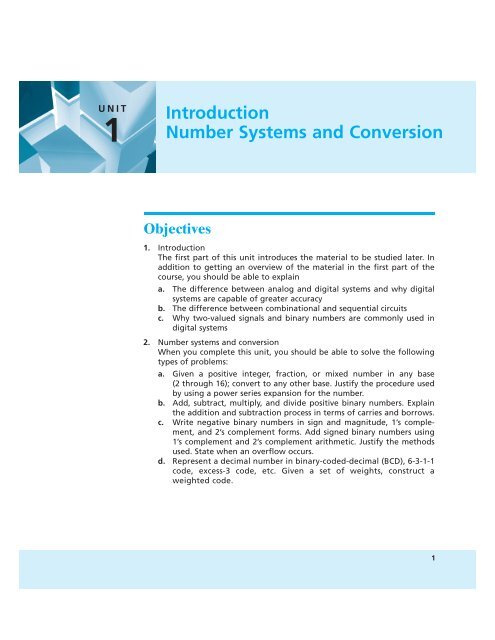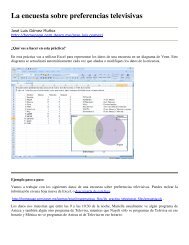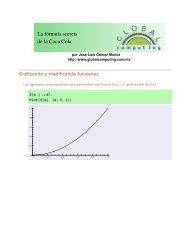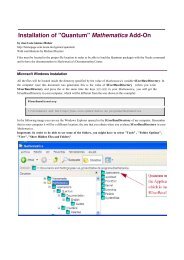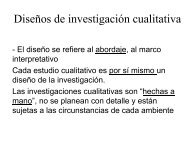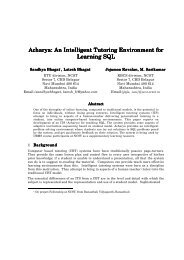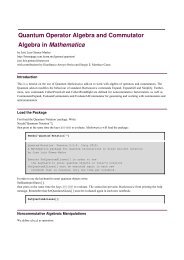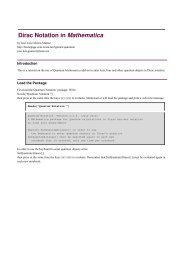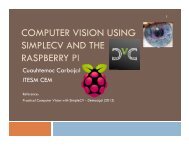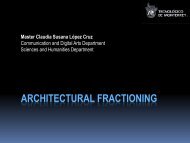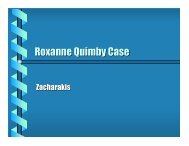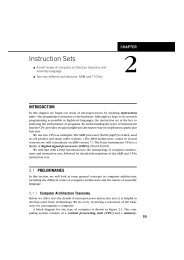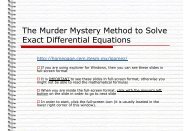Introduction Number Systems and Conversion
Introduction Number Systems and Conversion
Introduction Number Systems and Conversion
You also want an ePaper? Increase the reach of your titles
YUMPU automatically turns print PDFs into web optimized ePapers that Google loves.
UNIT1<strong>Introduction</strong><strong>Number</strong> <strong>Systems</strong> <strong>and</strong> <strong>Conversion</strong>Objectives1. <strong>Introduction</strong>The first part of this unit introduces the material to be studied later. Inaddition to getting an overview of the material in the first part of thecourse, you should be able to explaina. The difference between analog <strong>and</strong> digital systems <strong>and</strong> why digitalsystems are capable of greater accuracyb. The difference between combinational <strong>and</strong> sequential circuitsc. Why two-valued signals <strong>and</strong> binary numbers are commonly used indigital systems2. <strong>Number</strong> systems <strong>and</strong> conversionWhen you complete this unit, you should be able to solve the followingtypes of problems:a. Given a positive integer, fraction, or mixed number in any base(2 through 16); convert to any other base. Justify the procedure usedby using a power series expansion for the number.b. Add, subtract, multiply, <strong>and</strong> divide positive binary numbers. Explainthe addition <strong>and</strong> subtraction process in terms of carries <strong>and</strong> borrows.c. Write negative binary numbers in sign <strong>and</strong> magnitude, 1’s complement,<strong>and</strong> 2’s complement forms. Add signed binary numbers using1’s complement <strong>and</strong> 2’s complement arithmetic. Justify the methodsused. State when an overflow occurs.d. Represent a decimal number in binary-coded-decimal (BCD), 6-3-1-1code, excess-3 code, etc. Given a set of weights, construct aweighted code.1
2 Unit 1Study Guide1. Study Section 1.1, Digital <strong>Systems</strong> <strong>and</strong> Switching Circuits, <strong>and</strong> answer the followingstudy questions:(a) What is the basic difference between analog <strong>and</strong> digital systems?(b)Why are digital systems capable of greater accuracy than analog systems?(c)Explain the difference between combinational <strong>and</strong> sequential switchingcircuits.(d)What common characteristic do most switching devices used in digitalsystems have?(e)Why are binary numbers used in digital systems?2. Study Section 1.2, <strong>Number</strong> <strong>Systems</strong> <strong>and</strong> <strong>Conversion</strong>. Answer the following studyquestions as you go along:(a) Is the first remainder obtained in the division method for base conversionthe most or least significant digit?(b)(c)Work through all of the examples in the text as you encounter them <strong>and</strong>make sure that you underst<strong>and</strong> all of the steps.An easy method for conversion between binary <strong>and</strong> hexadecimal is illustratedin Equation (1-1). Why should you start forming the groups of fourbits at the binary point instead of the left end of the number?(d)Why is it impossible to convert a decimal number to binary on a digit-bydigitbasis as can be done for hexadecimal?
<strong>Number</strong> <strong>Systems</strong> <strong>and</strong> <strong>Conversion</strong> 3(e)Complete the following conversion table.Binary Octal Decimal Hexadecimal(base 2) (base 8) (base 10) (base 16)0 0 0 0110111001011101111000100110101011110011011110111110000 20 16 10(f) Work Problems 1.1, 1.2, 1.3, <strong>and</strong> 1.4.3. Study Section 1.3, Binary Arithmetic.(a) Make sure that you can follow all of the examples, especially the propagationof borrows in the subtraction process.(b) To make sure that you underst<strong>and</strong> the borrowing process, work out adetailed analysis in terms of powers of 2 for the following example:1100 1011114. Work Problems 1.5, 1.6, <strong>and</strong> 1.17(a).5. Study Section 1.4, Representation of Negative <strong>Number</strong>s.(a) In digital systems, why are 1’s complement <strong>and</strong> 2’s complement commonlyused to represent negative numbers instead of sign <strong>and</strong> magnitude?
4 Unit 1(b)State two different ways of forming the 1’s complement of an n-bit binarynumber.(c)State three different ways of forming the 2’s complement of an n-bitbinary number.(d)If the word length is n 4 bits (including sign), what decimal number does1000 2 represent in sign <strong>and</strong> magnitude?In 2’s complement?In 1’s complement?(e)Given a negative number represented in 2’s complement, how do youfind its magnitude?Given a negative number represented in 1’s complement, how do youfind its magnitude?(f)If the word length is 6 bits (including sign), what decimal number does100000 2 represent in sign <strong>and</strong> magnitude?In 2’s complement?In 1’s complement?(g)What is meant by an overflow? How can you tell that an overflow hasoccurred when performing 1’s or 2’s complement addition?Does a carry out of the last bit position indicate that an overflow hasoccurred?
<strong>Introduction</strong><strong>Number</strong> <strong>Systems</strong> <strong>and</strong> <strong>Conversion</strong>1.1 Digital <strong>Systems</strong> <strong>and</strong> Switching CircuitsDigital systems are used extensively in computation <strong>and</strong> data processing, controlsystems, communications, <strong>and</strong> measurement. Because digital systems are capable ofgreater accuracy <strong>and</strong> reliability than analog systems, many tasks formerly done byanalog systems are now being performed digitally.In a digital system, the physical quantities or signals can assume only discretevalues, while in analog systems the physical quantities or signals may vary continuouslyover a specified range. For example, the output voltage of a digital systemmight be constrained to take on only two values such as 0 volts <strong>and</strong> 5 volts,while the output voltage from an analog system might be allowed to assume anyvalue in the range 10 volts to 10 volts.Because digital systems work with discrete quantities, in many cases they can bedesigned so that for a given input, the output is exactly correct. For example, if wemultiply two 5-digit numbers using a digital multiplier, the 10-digit product will becorrect in all 10 digits. On the other h<strong>and</strong>, the output of an analog multiplier mighthave an error ranging from a fraction of one percent to a few percent dependingon the accuracy of the components used in construction of the multiplier.Furthermore, if we need a product which is correct to 20 digits rather than 10, wecan redesign the digital multiplier to process more digits <strong>and</strong> add more digits to itsinput. A similar improvement in the accuracy of an analog multiplier would not bepossible because of limitations on the accuracy of the components.The design of digital systems may be divided roughly into three parts—systemdesign, logic design, <strong>and</strong> circuit design. System design involves breaking the overallsystem into subsystems <strong>and</strong> specifying the characteristics of each subsystem. Forexample, the system design of a digital computer could involve specifying the number<strong>and</strong> type of memory units, arithmetic units, <strong>and</strong> input-output devices as wellas the interconnection <strong>and</strong> control of these subsystems. Logic design involvesdetermining how to interconnect basic logic building blocks to perform a specificfunction. An example of logic design is determining the interconnection of logicgates <strong>and</strong> flip-flops required to perform binary addition. Circuit design involvesspecifying the interconnection of specific components such as resistors, diodes, <strong>and</strong>6
...<strong>Number</strong> <strong>Systems</strong> <strong>and</strong> <strong>Conversion</strong> 7transistors to form a gate, flip-flop, or other logic building block. Most contemporarycircuit design is done in integrated circuit form using appropriate computeraideddesign tools to lay out <strong>and</strong> interconnect the components on a chip of silicon.This book is largely devoted to a study of logic design <strong>and</strong> the theory necessary forunderst<strong>and</strong>ing the logic design process. Some aspects of system design are treatedin Units 18 <strong>and</strong> 20. Circuit design of logic gates is discussed briefly in Appendix A.Many of a digital system’s subsystems take the form of a switching circuit(Figure 1-1). A switching circuit has one or more inputs <strong>and</strong> one or more outputswhich take on discrete values. In this text, we will study two types of switchingcircuits—combinational <strong>and</strong> sequential. In a combinational circuit, the output valuesdepend only on the present value of the inputs <strong>and</strong> not on past values. In asequential circuit, the outputs depend on both the present <strong>and</strong> past input values. Inother words, in order to determine the output of a sequential circuit, a sequence ofinput values must be specified. The sequential circuit is said to have memorybecause it must “remember” something about the past sequence of inputs, while acombinational circuit has no memory. In general, a sequential circuit is composed ofa combinational circuit with added memory elements. Combinational circuits areeasier to design than sequential circuits <strong>and</strong> will be studied first.FIGURE 1-1Switching CircuitInputsX 1X 2SwitchingCircuit...Z 1Z 2OutputsX mZ nThe basic building blocks used to construct combinational circuits are logic gates.The logic designer must determine how to interconnect these gates in order to convertthe circuit input signals into the desired output signals. The relationship between theseinput <strong>and</strong> output signals can be described mathematically using Boolean algebra. Units2 <strong>and</strong> 3 of this text introduce the basic laws <strong>and</strong> theorems of Boolean algebra <strong>and</strong> showhow they can be used to describe the behavior of circuits of logic gates.Starting from a given problem statement, the first step in designing a combinationallogic circuit is to derive a table or the algebraic logic equations which describethe circuit outputs as a function of the circuit inputs (Unit 4). In order to designan economical circuit to realize these output functions, the logic equationswhich describe the circuit outputs generally must be simplified. Algebraic methodsfor this simplification are described in Unit 3, <strong>and</strong> other simplification methods(Karnaugh map <strong>and</strong> Quine-McCluskey procedure) are introduced in Units 5 <strong>and</strong> 6.Implementation of the simplified logic equations using several types of gates isdescribed in Unit 7, <strong>and</strong> alternative design procedures using programmable logicdevices are developed in Unit 9.The basic memory elements used in the design of sequential circuits are calledflip-flops (Unit 11).These flip-flops can be interconnected with gates to form counters<strong>and</strong> registers (Unit 12). Analysis of more general sequential circuits using
8 Unit 1timing diagrams, state tables, <strong>and</strong> graphs is presented in Unit 13. The first step indesigning a sequential switching circuit is to construct a state table or graph whichdescribes the relationship between the input <strong>and</strong> output sequences (Unit 14).Methods for going from a state table or graph to a circuit of gates <strong>and</strong> flip-flops aredeveloped in Unit 15. Methods of implementing sequential circuits using programmablelogic are discussed in Unit 16. In Unit 18, combinational <strong>and</strong> sequentialdesign techniques are applied to the realization of systems for performing binaryaddition, multiplication, <strong>and</strong> division. The sequential circuits designed in this textare called synchronous sequential circuits because they use a common timing signal,called a clock, to synchronize the operation of the memory elements.Use of a hardware description language, VHDL, in the design of combinationallogic, sequential logic, <strong>and</strong> digital systems is introduced in Units 10, 17, <strong>and</strong> 20.VHDL is used to describe, simulate, <strong>and</strong> synthesize digital hardware. After writingVHDL code, the designer can use computer-aided design software to compile thehardware description <strong>and</strong> complete the design of the digital logic. This allows thecompletion of complex designs without having to manually work out detailed circuitdescriptions in terms of gates <strong>and</strong> flip-flops.The switching devices used in digital systems are generally two-state devices,that is, the output can assume only two different discrete values. Examples ofswitching devices are relays, diodes, <strong>and</strong> transistors. A relay can assume twostates—closed or open—depending on whether power is applied to the coil or not.A diode can be in a conducting state or a nonconducting state. A transistor can bein a cut-off or saturated state with a corresponding high or low output voltage. Ofcourse, transistors can also be operated as linear amplifiers with a continuousrange of output voltages, but in digital applications greater reliability is obtainedby operating them as two-state devices. Because the outputs of most switchingdevices assume only two different values, it is natural to use binary numbersinternally in digital systems. For this reason binary numbers <strong>and</strong> number systemswill be discussed first before proceeding to the design of switching circuits.1.2 <strong>Number</strong> <strong>Systems</strong> <strong>and</strong> <strong>Conversion</strong>When we write decimal (base 10) numbers, we use a positional notation; each digitis multiplied by an appropriate power of 10 depending on its position in the number.For example,953.78 10 9 10 2 5 10 1 3 10 0 7 10 1 8 10 2Similarly, for binary (base 2) numbers, each binary digit is multiplied by the appropriatepower of 2:1011.11 2 1 2 3 0 2 2 1 2 1 1 2 0 1 2 1 1 2 212 8 0 2 1 11 11.75 101434
<strong>Number</strong> <strong>Systems</strong> <strong>and</strong> <strong>Conversion</strong> 9Note that the binary point separates the positive <strong>and</strong> negative powers of 2 just asthe decimal point separates the positive <strong>and</strong> negative powers of 10 for decimalnumbers.Any positive integer R (R 1) can be chosen as the radix or base of a number system.If the base is R, then R digits (0, 1, . . . , R1) are used. For example, if R 8, thenthe required digits are 0, 1, 2, 3, 4, 5, 6, <strong>and</strong> 7. A number written in positional notationcan be exp<strong>and</strong>ed in a power series in R. For example,N (a 4 a 3 a 2 a 1 a 0 .a 1 a 2 a 3 ) R a 4 R 4 a 3 R 3 a 2 R 2 a 1 R 1 a 0 R 0 a 1 R 1 a 2 R 2 a 3 R 3where a i is the coefficient of R i <strong>and</strong> 0 a i R1. If the arithmetic indicated in thepower series expansion is done in base 10, then the result is the decimal equivalentof N. For example,147.3 8 1 8 2 4 8 1 7 8 0 3 8 1 64 32 7 103.375 10The power series expansion can be used to convert to any base. For example,converting 147 10 to base 3 would be written as147 10 1 (101) 2 (11) (101) 1 (21) (101) 0where all the numbers on the right-h<strong>and</strong> side are base 3 numbers. (Note: Inbase 3, 10 is 101, 7 is 21, etc.) To complete the conversion, base 3 arithmeticwould be used. Of course, this is not very convenient if the arithmetic is beingdone by h<strong>and</strong>. Similarly, if 147 10 is being converted to binary, the calculationwould be147 10 1 (1010) 2 (100) (1010) 1 (111) (1010) 0Again this is not convenient for h<strong>and</strong> calculation but it could be done easily in acomputer where the arithmetic is done in binary. For h<strong>and</strong> calculation, use thepower series expansion when converting from some base into base 10.For bases greater than 10, more than 10 symbols are needed to represent thedigits. In this case, letters are usually used to represent digits greater than 9. Forexample, in hexadecimal (base 16), A represents 10 10 , B represents 11 10 , C represents12 10 , D represents 13 10 , E represents 14 10 , <strong>and</strong> F represents 15 10 . Thus,A2F 16 10 16 2 2 16 1 15 16 0 2560 32 15 2607 10Next, we will discuss conversion of a decimal integer to base R using the divisionmethod. The base R equivalent of a decimal integer N can be represented asN (a n a n1 ··· a 2 a 1 a 0 ) R a n R n a n1 R n1 · · · a 2 R 2 a 1 R 1 a 0
10 Unit 1If we divide N by R, the remainder is a 0 :NR a n R n1 a n1 R n2 · · · a 2 R 1 a 1 Q 1 , remainder a 0Then we divide the quotient Q 1 by R:Q 1RNext we divide Q 2 by R: a n R n2 a n1 R n3 · · · a 3 R 1 a 2 Q 2 , remainder a 1Q 2R a n R n3 a n1 R n4 · · · a 3 Q 3 , remainder a 2This process is continued until we finally obtain a n . Note that the remainderobtained at each division step is one of the desired digits <strong>and</strong> the least significantdigit is obtained first.ExampleConvert 53 10 to binary.2 532 26 rem. 1 a 02 13 rem. 0 a 12 6 rem. 1 a 2 53 10 110101 22 3 rem. 0 a 32 1 rem. 1 a 40 rem. 1 a 5<strong>Conversion</strong> of a decimal fraction to base R can be done using successive multiplicationsby R. A decimal fraction F can be represented asF (.a 1 a 2 a 3 · · · a m ) R a 1 R 1 a 2 R 2 a 3 R 3 · · · a m R mMultiplying by R yieldsFR a 1 a 2 R 1 a 3 R 2 · · · a m R m1 a 1 F 1where F 1 represents the fractional part of the result <strong>and</strong> a 1 is the integer part.Multiplying F 1 by R yieldsF 1 R a 2 a 3 R 1 · · · a m R m2 a 2 F 2
<strong>Number</strong> <strong>Systems</strong> <strong>and</strong> <strong>Conversion</strong> 11Next, we multiply F 2 by R:F 2 R a 3 · · · a m R m3 a 3 F 3This process is continued until we have obtained a sufficient number of digits. Notethat the integer part obtained at each step is one of the desired digits <strong>and</strong> the mostsignificant digit is obtained first.ExampleConvert 0.625 10 to binary.F .625 F 1 .250 F 2 .500 2 2 2 .625 10 .101 21.250 0.500 1.000(a 1 1) (a 2 0) (a 3 1)This process does not always terminate, but if it does not terminate, the result isa repeating fraction.ExampleConvert 0.7 10 to binary..72(1).42(0).82(1).62(1).22(0).4 ←⎯ process starts repeating here because 0.4 was previously2 obtained(0).8 0.7 10 0.1 0110 0110 0110 . . . 2<strong>Conversion</strong> between two bases other than decimal can be done directly by usingthe procedures given; however, the arithmetic operations would have to be carriedout using a base other than 10. It is generally easier to convert to decimal first <strong>and</strong>then convert the decimal number to the new base.
12 Unit 1ExampleConvert 231.3 4 to base 7.231.3 4 2 16 3 4 1 45.75 107 45.757 6 rem. 3 70 rem. 6 (5) .25 45.75 10 63.5151 . . . 77(1) .757(5) .257(1) .7534<strong>Conversion</strong> from binary to hexadecimal (<strong>and</strong> conversely) can be done by inspectionbecause each hexadecimal digit corresponds to exactly four binary digits (bits).Starting at the binary point, the bits are divided into groups of four, <strong>and</strong> each groupis replaced by a hexadecimal digit:1001101.010111 2 0100 ¯1101 ¯ · ¯0101 1100 ¯ 4D.5C 16 (1-1)4 D 5 CAs shown in Equation (1-1), extra 0’s are added at each end of the bit string asneeded to fill out the groups of four bits.¯¯¯¯1.3 Binary ArithmeticArithmetic operations in digital systems are usually done in binary because designof logic circuits to perform binary arithmetic is much easier than for decimal. Binaryarithmetic is carried out in much the same manner as decimal, except the addition<strong>and</strong> multiplication tables are much simpler.The addition table for binary numbers is0 0 00 1 11 0 11 1 0 <strong>and</strong> carry 1 to the next columnCarrying 1 to a column is equivalent to adding 1 to that column.
<strong>Number</strong> <strong>Systems</strong> <strong>and</strong> <strong>Conversion</strong> 13ExampleAdd 13 10 <strong>and</strong> 11 10 in binary.1111 ←⎯ carries13 10 110111 10 101111000 24 10The subtraction table for binary numbers is0 0 00 1 1 <strong>and</strong> borrow 1 from the next column1 0 11 1 0Borrowing 1 from a column is equivalent to subtracting 1 from that column.Examplesof BinarySubtraction(a) 1←⎯ (indicates (b) 1111←⎯ borrows (c) 111←⎯ borrows11101 a borrrow 10000 11100110011 from the 11 10111010 3rd column) 1101 101110Note how the borrow propagates from column to column in the second example.In order to borrow 1 from the second column, we must in turn borrow 1 fromthe third column, etc. An alternative to binary subtraction is the use of 2’s complementarithmetic, as discussed in Section 1.4.Binary subtraction sometimes causes confusion, perhaps because we are so usedto doing decimal subtraction that we forget the significance of the borrowingprocess. Before doing a detailed analysis of binary subtraction, we will review theborrowing process for decimal subtraction.If we number the columns (digits) of a decimal integer from right toleft (starting with 0), <strong>and</strong> then we borrow 1 from column n, what we mean is thatwe subtract 1 from column n <strong>and</strong> add 10 to column n 1. Because 1 10 n 10 10 n1 , the value of the decimal number is unchanged, but we can proceedwith the subtraction. Consider, for example, the following decimal subtractionproblem:column 2 column 1205 18←⎯←187
14 Unit 1A detailed analysis of the borrowing process for this example, indicating first a borrowof 1 from column 1 <strong>and</strong> then a borrow of 1 from column 2, is as follows:205 18 [2 10 2 0 10 1 5 10 0 ] [ 1 10 1 8 10 0 ]↓ ↓note borrow from column 1 [2 10 2 (0 1) 10 1 (10 5) 10 0 ] [ 1 10 1 8 10 0 ]↓ ↓note borrow from column 2 [(2 1) 10 2 (10 0 1) 10 1 15 10 0 ] [ 1 10 1 8 10 0 ] [1 10 2 8 10 1 7 10 0 ] 187The analysis of borrowing for binary subtraction is exactly the same, except that wework with powers of 2 instead of powers of 10. Thus for a binary number, borrowing 1from column n is equivalent to subtracting 1 from column n <strong>and</strong> adding 2 (10 2 ) to columnn 1. The value of the binary number is unchanged because 1 2 n 2 2 n1 .A detailed analysis of binary subtraction example (c) follows. Starting with therightmost column, 1 1 0. To subtract in the second column, we must borrowfrom the third column. Rather than borrow immediately, we place a 1 over the thirdcolumn to indicate that a borrow is necessary, <strong>and</strong> we will actually do the borrowingwhen we get to the third column. (This is similar to the way borrow signals mightpropagate in a computer.) Now because we have borrowed 1, the second columnbecomes 10, <strong>and</strong> 10 1 1. In order to borrow 1 from the third column, we mustborrow 1 from the fourth column (indicated by placing a 1 over column 4). Column3 then becomes 10, subtracting off the borrow yields 1, <strong>and</strong> 1 0 1. Now in column4, we subtract off the borrow leaving 0. In order to complete the subtraction,we must borrow from column 5, which gives 10 in column 4, <strong>and</strong> 10 1 1.The multiplication table for binary numbers is0 0 00 1 01 0 01 1 1The following example illustrates multiplication of 13 10 by 11 10 in binary:11011011110111010000110110001111 143 10
<strong>Number</strong> <strong>Systems</strong> <strong>and</strong> <strong>Conversion</strong> 15Note that each partial product is either the multiplic<strong>and</strong> (1101) shifted over theappropriate number of places or is zero.When adding up long columns of binary numbers, the sum of the bits in a singlecolumn can exceed 11 2 , <strong>and</strong> therefore the carry to the next column can begreater than 1. For example, if a single column of bits contains five 1’s, thenadding up the 1’s gives 101 2 , which means that the sum bit for that column is 1,<strong>and</strong> the carry to the next column is 10 2 . When doing binary multiplication, a commonway to avoid carries greater than 1 is to add in the partial products one at atime as illustrated by the following example:1111 multiplic<strong>and</strong>1101 multiplier1111 first partial product0000 second partial product(01111) sum of first two partial products1111 third partial product(1001011) sum after adding third partial product1111 fourth partial product11000011 final product (sum after adding fourth partial product)The following example illustrates division of 145 10 by 11 10 in binary:11011011 100100011011111010111101 The quotient is 1101 with a remainder1011 of 10.10Binary division is similar to decimal division, except it is much easier because theonly two possible quotient digits are 0 <strong>and</strong> 1. In the above example, if we start bycomparing the divisor (1011) with the upper four bits of the dividend (1001), wefind that we cannot subtract without a negative result, so we move the divisorone place to the right <strong>and</strong> try again. This time we can subtract 1011 from 10010to give 111 as a result, so we put the first quotient bit of 1 above 10010. We thenbring down the next dividend bit (0) to get 1110 <strong>and</strong> shift the divisor right. Wethen subtract 1011 from 1110 to get 11, so the second quotient bit is 1. When webring down the next dividend bit, the result is 110, <strong>and</strong> we cannot subtract theshifted divisor, so the third quotient bit is 0. We then bring down the last dividendbit <strong>and</strong> subtract 1011 from 1101 to get a final remainder of 10, <strong>and</strong> the lastquotient bit is 1.
16 Unit 11.4 Representation of Negative <strong>Number</strong>sUp to this point we have been working with unsigned positive numbers. In mostcomputers, in order to represent both positive <strong>and</strong> negative numbers the first bit ina word is used as a sign bit, with 0 used for plus <strong>and</strong> 1 used for minus. Several representationsof negative binary numbers are possible. The sign <strong>and</strong> magnitude systemis similar to that which people commonly use. For an n-bit word, the first bit isthe sign <strong>and</strong> the remaining n 1 bits represent the magnitude of the number. Thusan n-bit word can represent any one of 2 n1 positive integers or 2 n1 negative integers.Table 1-1 illustrates this for n 4. For example, 0011 represents 3 <strong>and</strong> 1011represents 3. Note that 1000 represents minus zero in the sign <strong>and</strong> magnitude system<strong>and</strong> 8 in the 2’s complement system.The design of logic circuits to do arithmetic with sign <strong>and</strong> magnitude binarynumbers is awkward; therefore, other representations are often used. The 2’s complement<strong>and</strong> 1’s complement are commonly used because arithmetic units are easyto design using these systems. For the 2’s complement number system, a positivenumber, N, is represented by a 0 followed by the magnitude as in the sign <strong>and</strong> magnitudesystem; however, a negative number, N, is represented by its 2’s complement,N*. If the word length is n bits, the 2’s complement of a positive integer N isdefined as for a word length of n bits.N* 2 n N (1-2)For n 4, N is represented by 16 N as shown in Table 1-1. For example, 3 isrepresented by 16 3 13 1101 2 .As is the case for sign <strong>and</strong> magnitude numbers,all negative 2’s complement numbers have a 1 in the position furthest to the left(sign bit).For the 1’s complement system a negative number, N, is represented by its 1’scomplement, N. The 1’s complement of a positive integer N is defined asN (2 n 1) N (1-3)TABLE 1-1Signed BinaryIntegers (wordlength: n 4)PositiveNegative IntegersIntegers Sign <strong>and</strong> 2’s Complement 1’s ComplementN (all systems) N Magnitude N* N –0 0000 0 1000 —— 11111 0001 1 1001 1111 11102 0010 2 1010 1110 11013 0011 3 1011 1101 11004 0100 4 1100 1100 10115 0101 5 1101 1011 10106 0110 6 1110 1010 10017 0111 7 1111 1001 10008 —— 1000 ——
22 Unit 1valid code is that each decimal digit be represented by a distinct combinationof binary digits. To translate a decimal number to coded form, each decimaldigit is replaced by its corresponding code. Thus 937 expressed in excess-3code is 1100 0110 1010. The 8-4-2-1 (BCD) code <strong>and</strong> the 6-3-1-1 code are examplesof weighted codes. A 4-bit weighted code has the property that ifthe weights are w 3 , w 2 , w 1 , <strong>and</strong> w 0 , the code a 3 a 2 a 1 a 0 represents a decimal numberN, whereN w 3 a 3 w 2 a 2 w 1 a 1 w 0 a 0For example, the weights for the 6-3-1-1 code are w 3 6, w 2 3, w 1 l, <strong>and</strong> w 0 l.The binary code 1011 thus represents the decimal digitN 61 30 11 11 8The excess-3 code is obtained from the 8-4-2-1 code by adding 3 (0011) toeach of the codes. The 2-out-of-5 code has the property that exactly 2 out of the5 bits are 1 for every valid code combination. This code has useful error-checkingproperties because if any one of the bits in a code combination is changeddue to a malfunction of the logic circuitry, the number of 1 bits is no longerexactly two. The table shows one example of a Gray code. A Gray code has theproperty that the codes for successive decimal digits differ in exactly one bit. Forexample, the codes for 6 <strong>and</strong> 7 differ only in the fourth bit, <strong>and</strong> the codes for9 <strong>and</strong> 0 differ only in the first bit. A Gray code is often used when translatingan analog quantity, such as a shaft position, into digital form. In this case, a smallchange in the analog quantity will change only one bit in the code, whichgives more reliable operation than if two or more bits changed at a time. TheGray <strong>and</strong> 2-out-of-5 codes are not weighted codes. In general, the decimal valueof a coded digit cannot be computed by a simple formula when a non-weightedcode is used.Many applications of computers require the processing of data which containsnumbers, letters, <strong>and</strong> other symbols such as punctuation marks. In order to transmitsuch alphanumeric data to or from a computer or store it internally in a computer,each symbol must be represented by a binary code. One common alphanumericcode is the ASCII code (American St<strong>and</strong>ard Code for Information Interchange).This is a 7-bit code, so 2 7 (128) different code combinations are available to representletters, numbers, <strong>and</strong> other symbols. Table 1-3 shows a portion of the ASCIIcode; the code combinations not listed are used for special control functions such as“form feed” or “end of transmission.”The word “Start” is represented in ASCII codeas follows:1010011 1110100 1100001 1110010 1110100S t a r t
<strong>Number</strong> <strong>Systems</strong> <strong>and</strong> <strong>Conversion</strong> 23TABLE 1-3ASCII CodeASCII Code ASCII Code ASCII CodeCharacter A 6 A 5 A 4 A 3 A 2 A 1 A 0 Character A 6 A 5 A 4 A 3 A 2 A 1 A 0 Character A 6 A 5 A 4 A 3 A 2 A 1 A 0space 0 1 0 0 0 0 0 @ 1 0 0 0 0 0 0 ‘ 1 1 0 0 0 0 0! 0 1 0 0 0 0 1 A 1 0 0 0 0 0 1 a 1 1 0 0 0 0 1“ 0 1 0 0 0 1 0 B 1 0 0 0 0 1 0 b 1 1 0 0 0 1 0# 0 1 0 0 0 1 1 C 1 0 0 0 0 1 1 c 1 1 0 0 0 1 1$ 0 1 0 0 1 0 0 D 1 0 0 0 1 0 0 d 1 1 0 0 1 0 0% 0 1 0 0 1 0 1 E 1 0 0 0 1 0 1 e 1 1 0 0 1 0 1& 0 1 0 0 1 1 0 F 1 0 0 0 1 1 0 f 1 1 0 0 1 1 0 0 1 0 0 1 1 1 G 1 0 0 0 1 1 1 g 1 1 0 0 1 1 1( 0 1 0 1 0 0 0 H 1 0 0 1 0 0 0 h 1 1 0 1 0 0 0) 0 1 0 1 0 0 1 I 1 0 0 1 0 0 1 i 1 1 0 1 0 0 1* 0 1 0 1 0 1 0 J 1 0 0 1 0 1 0 j 1 1 0 1 0 1 0 0 1 0 1 0 1 1 K 1 0 0 1 0 1 1 k 1 1 0 1 0 1 1, 0 1 0 1 1 0 0 L 1 0 0 1 1 0 0 l 1 1 0 1 1 0 0 0 1 0 1 1 0 1 M 1 0 0 1 1 0 1 m 1 1 0 1 1 0 1. 0 1 0 1 1 1 0 N 1 0 0 1 1 1 0 n 1 1 0 1 1 1 0/ 0 1 0 1 1 1 1 O 1 0 0 1 1 1 1 o 1 1 0 1 1 1 10 0 1 1 0 0 0 0 P 1 0 1 0 0 0 0 p 1 1 1 0 0 0 01 0 1 1 0 0 0 1 Q 1 0 1 0 0 0 1 q 1 1 1 0 0 0 12 0 1 1 0 0 1 0 R 1 0 1 0 0 1 0 r 1 1 1 0 0 1 03 0 1 1 0 0 1 1 S 1 0 1 0 0 1 1 s 1 1 1 0 0 1 14 0 1 1 0 1 0 0 T 1 0 1 0 1 0 0 t 1 1 1 0 1 0 05 0 1 1 0 1 0 1 U 1 0 1 0 1 0 1 u 1 1 1 0 1 0 16 0 1 1 0 1 1 0 V 1 0 1 0 1 1 0 v 1 1 1 0 1 1 07 0 1 1 0 1 1 1 W 1 0 1 0 1 1 1 w 1 1 1 0 1 1 18 0 1 1 1 0 0 0 X 1 0 1 1 0 0 0 x 1 1 1 1 0 0 09 0 1 1 1 0 0 1 Y 1 0 1 1 0 0 1 y 1 1 1 1 0 0 1: 0 1 1 1 0 1 0 Z 1 0 1 1 0 1 0 z 1 1 1 1 0 1 0; 0 1 1 1 0 1 1 [ 1 0 1 1 0 1 1 { 1 1 1 1 0 1 1 0 1 1 1 1 0 0 \ 1 0 1 1 1 0 0 ⏐ 1 1 1 1 1 0 0 0 1 1 1 1 0 1 ] 1 0 1 1 1 0 1 } 1 1 1 1 1 0 1 0 1 1 1 1 1 0 ^ 1 0 1 1 1 1 0 ~ 1 1 1 1 1 1 0? 0 1 1 1 1 1 1 — 1 0 1 1 1 1 1 delete 1 1 1 1 1 1 1Problems1.1 Convert to hexadecimal <strong>and</strong> then to binary:(a) 757.25 10 (b) 123.17 10 (c) 356.89 10 (d) 1063.5 101.2 Convert to octal. Convert to hexadecimal. Then convert both of your answers todecimal, <strong>and</strong> verify that they are the same.(a) 111010110001.011 2 (b) 10110011101.11 2
24 Unit 11.3 Convert to base 6: 3BA.25 14 (do all of the arithmetic in decimal).1.4 (a) Convert to hexadecimal: 1457.11 10 . Round to two digits past the hexadecimal point.(b) Convert your answer to binary, <strong>and</strong> then to octal.(c) Devise a scheme for converting hexadecimal directly to base 4 <strong>and</strong> convert youranswer to base 4.(d) Convert to decimal: DEC.A 16 .1.5 Add, subtract, <strong>and</strong> multiply in binary:(a) 1111 <strong>and</strong> 1010 (b) 110110 <strong>and</strong> 11101 (c) 100100 <strong>and</strong> 101101.6 Subtract in binary. Place a 1 over each column from which it was necessary to borrow.(a) 11110100 1000111 (b) 1110110 111101 (c) 10110010 1111011.7 Add the following numbers in binary using 2’s complement to represent negative numbers.Use a word length of 6 bits (including sign) <strong>and</strong> indicate if an overflow occurs.(a) 21 11 (b) (14) (32) (c) (25) 18(d) (12) 13 (e) (11) (21)Repeat (a), (c), (d), <strong>and</strong> (e) using 1’s complement to represent negative numbers.1.8 A computer has a word length of 8 bits (including sign). If 2’s complement is used torepresent negative numbers, what range of integers can be stored in the computer?If 1’s complement is used? (Express your answers in decimal.)1.9 Construct a table for 7-3-2-1 weighted code <strong>and</strong> write 3659 using this code.1.10 Convert to hexadecimal <strong>and</strong> then to binary.(a) 1305.375 10 (b) 111.33 10 (c) 301.12 10 (d) 1644.875 101.11 Convert to octal. Convert to hexadecimal. Then convert both of your answers todecimal, <strong>and</strong> verify that they are the same.(a) 101111010100.101 2 (b) 100001101111.01 21.12 (a) Convert to base 3: 375.54 8 (do all of the arithmetic in decimal).(b) Convert to base 4: 384.74 10 .(c) Convert to base 9: A52.A4 11 (do all of the arithmetic in decimal).1.13 Convert to hexadecimal <strong>and</strong> then to binary: 544.1 9 .1.14 Convert the decimal number 97.7 10 into a number with exactly the same value representedin the following bases. The exact value requires an infinite repeating partin the fractional part of the number. Show the steps of your derivation.(a) binary (b) octal (c) hexadecimal (d) base 3 (e) base 51.15 Devise a scheme for converting base 3 numbers directly to base 9. Use your methodto convert the following number to base 9: 1110212.20211 3
<strong>Number</strong> <strong>Systems</strong> <strong>and</strong> <strong>Conversion</strong> 251.16 Convert the following decimal numbers to octal <strong>and</strong> then to binary:(a) 2983 63 / 64 (b) 93.70 (c) 1900 31 / 32 (d) 109.301.17 Add, subtract, <strong>and</strong> multiply in binary:(a) 1111 <strong>and</strong> 1001 (b) 1101001 <strong>and</strong> 110110 (c) 110010 <strong>and</strong> 111011.18 Subtract in binary. Place a 1 over each column from which it was necessary to borrow.(a) 10100100 01110011 (b) 10010011 01011001(c) 11110011 100111101.19 Divide in binary:(a) 11101001 101 (b) 110000001 1110 (c) 1110010 1001Check your answers by multiplying out in binary <strong>and</strong> adding the remainder.1.20 Divide in binary:(a) 10001101 110 (b) 110000011 1011 (c) 1110100 10101.21 Assume three digits are used to represent positive integers <strong>and</strong> also assume the followingoperations are correct. Determine the base of the numbers. Did any of theadditions overflow?(a) 654 013 000(b) 024 043 013 033 223(c) 024 043 013 033 2011.22 What is the lowest number of bits (digits) required in the binary number approximatelyequal to the decimal number 0.6117 10 so that the binary number has thesame or better precision?1.23 Convert 0.363636. . . 10 to its exact equivalent base 8 number.1.24 (a) Verify that a number in base b can be converted to base b 3 by partitioning thedigits of the base b number into groups of three consecutive digits starting at theradix point <strong>and</strong> proceeding both left <strong>and</strong> right <strong>and</strong> converting each group intoa base b 3 digit. (Hint: Represent the base b number using the power seriesexpansion.)(b) Verify that a number in base b 3 can be converted to base b by exp<strong>and</strong>ing eachdigit of the base b 3 number into three consecutive digits starting at the radixpoint <strong>and</strong> proceeding both left <strong>and</strong> right.1.25 Construct a table for 4-3-2-1 weighted code <strong>and</strong> write 9154 using this code.1.26 Is it possible to construct a 5-3-1-1 weighted code? A 6-4-1-1 weighted code? Justifyyour answers.1.27 Is it possible to construct a 5-4-1-1 weighted code? A 6-3-2-1 weighte code? Justifyyour answers.
26 Unit 11.28 Construct a 6-2-2-1 weighted code for decimal digits. What number does 1100 0011represent in this code?1.29 Construct a 5-2-2-1 weighted code for decimal digits. What numbers does 1110 0110represent in this code?1.30 Construct a 7-3-2-1 code for base 12 digits. Write B4A9 using this code.1.31 (a) It is possible to have negative weights in a weighted code for the decimal digits,e.g.,8,4,2, <strong>and</strong> 1 can be used. Construct a table for this weighted code.(b) If d is a decimal digit in this code, how can the code for 9 – d be obtained?1.32 Convert to hexadecimal, <strong>and</strong> then give the ASCII code for the resulting hexadecimalnumber (including the code for the hexadecimal point):(a) 222.22 10 (b) 183.81 101.33 Repeat 1.7 for the following numbers:(a) (10) (11) (b) (10) (6) (c) (8) (11)(d) 11 9(e) (11) (4)1.34 Because A B A (B), the subtraction of signed numbers can be accomplishedby adding the complement. Subtract each of the following pairs of 5-bitbinary numbers by adding the complement of the subtrahend to the minuend.Indicate when an overflow occurs. Assume that negative numbers are representedin 1’s complement. Then repeat using 2’s complement.(a) 01001 (b) 11010 (c) 10110 (d) 11011 (e) 1110011010 11001 01101 00111 101011.35 Work Problem 1.34 for the following pairs of numbers:(a) 11010 (b) 01011 (c) 10001 (d) 1010110100 11000 01010 110101.36 (a) A 101010 <strong>and</strong> B 011101 are 1’s complement numbers. Perform the followingoperations <strong>and</strong> indicate whether overflow occurs.(i) A B (ii) A B(b) Repeat Part (a) assuming the numbers are 2’s complement numbers.1.37 (a) Assume the integers below are 1’s complement integers. Find the 1’s complementof each number, <strong>and</strong> give the decimal values of the original number <strong>and</strong>of its complement.(i) 0000000 (ii) 1111111 (iii) 00110011 (iv) 1000000(b) Repeat, assuming the numbers are 2’s complement numbers <strong>and</strong> finding the 2’scomplement of them.


